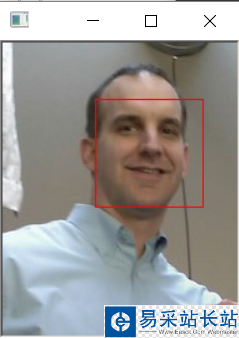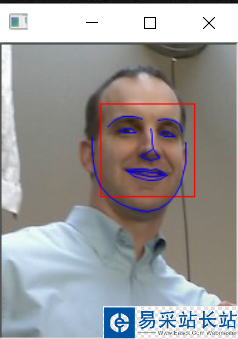0.引言
自己在下載dlib官網給的example代碼時,一開始不知道怎么使用,在一番摸索之后弄明白怎么使用了;
現分享下 face_detector.py 和 face_landmark_detection.py 這兩個py的使用方法;
1.簡介
python: 3.6.3
dlib: 19.7
利用dlib的特征提取器,進行人臉 矩形框 的特征提取:
dets = dlib.get_frontal_face_detector(img)
利用dlib的68點特征預測器,進行人臉 68點 特征提取:
predictor = dlib.shape_predictor("shape_predictor_68_face_landmarks.dat")shape = predictor(img, dets[0])效果:


(a) face_detector.py
b) face_landmark_detection.py
2.py文件功能介紹
face_detector.py :
識別出圖片文件中一張或多張人臉,并用矩形框框出標識出人臉;
link: http://dlib.net/cnn_face_detector.py.html
face_landmark_detection.py :在face_detector.py的識別人臉基礎上,識別出人臉部的具體特征部位:下巴輪廓、眉毛、眼睛、嘴巴,同樣用標記標識出面部特征;
link: http://dlib.net/face_landmark_detection.py.html
2.1. face_detector.py
官網給的face_detector.py
#!/usr/bin/python# The contents of this file are in the public domain. See LICENSE_FOR_EXAMPLE_PROGRAMS.txt## This example program shows how to find frontal human faces in an image. In# particular, it shows how you can take a list of images from the command# line and display each on the screen with red boxes overlaid on each human# face.## The examples/faces folder contains some jpg images of people. You can run# this program on them and see the detections by executing the# following command:# ./face_detector.py ../examples/faces/*.jpg## This face detector is made using the now classic Histogram of Oriented# Gradients (HOG) feature combined with a linear classifier, an image# pyramid, and sliding window detection scheme. This type of object detector# is fairly general and capable of detecting many types of semi-rigid objects# in addition to human faces. Therefore, if you are interested in making# your own object detectors then read the train_object_detector.py example# program. ### COMPILING/INSTALLING THE DLIB PYTHON INTERFACE# You can install dlib using the command:# pip install dlib## Alternatively, if you want to compile dlib yourself then go into the dlib# root folder and run:# python setup.py install# or# python setup.py install --yes USE_AVX_INSTRUCTIONS# if you have a CPU that supports AVX instructions, since this makes some# things run faster. ## Compiling dlib should work on any operating system so long as you have# CMake and boost-python installed. On Ubuntu, this can be done easily by# running the command:# sudo apt-get install libboost-python-dev cmake## Also note that this example requires scikit-image which can be installed# via the command:# pip install scikit-image# Or downloaded from http://scikit-image.org/download.html. import sysimport dlibfrom skimage import iodetector = dlib.get_frontal_face_detector()win = dlib.image_window()for f in sys.argv[1:]: print("Processing file: {}".format(f)) img = io.imread(f) # The 1 in the second argument indicates that we should upsample the image # 1 time. This will make everything bigger and allow us to detect more # faces. dets = detector(img, 1) print("Number of faces detected: {}".format(len(dets))) for i, d in enumerate(dets): print("Detection {}: Left: {} Top: {} Right: {} Bottom: {}".format( i, d.left(), d.top(), d.right(), d.bottom())) win.clear_overlay() win.set_image(img) win.add_overlay(dets) dlib.hit_enter_to_continue()# Finally, if you really want to you can ask the detector to tell you the score# for each detection. The score is bigger for more confident detections.# The third argument to run is an optional adjustment to the detection threshold,# where a negative value will return more detections and a positive value fewer.# Also, the idx tells you which of the face sub-detectors matched. This can be# used to broadly identify faces in different orientations.if (len(sys.argv[1:]) > 0): img = io.imread(sys.argv[1]) dets, scores, idx = detector.run(img, 1, -1) for i, d in enumerate(dets): print("Detection {}, score: {}, face_type:{}".format( d, scores[i], idx[i]))
新聞熱點
疑難解答